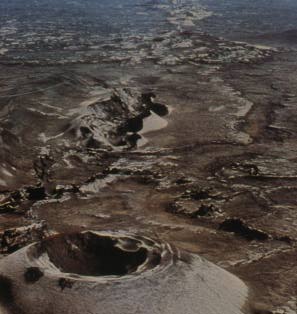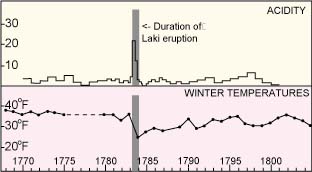
The Laki eruption lasted eight months during which time about 14 cubic km of basaltic lava and some tephra were erupted. Haze from the eruption was reported from Iceland to Syria. In Iceland, the haze lead to the loss of most of the island's livestock (by eating fluorine contaminated grass), crop failure (by acid rain), and the death of one-quarter of the human residents (by famine). Ben Franklin noted the atmospheric effects of the eruption (Wood, 1992). Photo of main fissure at Laki by Thor Thordarson.
It is estimated that 80 Mt of sulfuric acid aerosol was released by the eruption (4 times more than El Chichon and 80 times more than Mount St. Helens).

The climatic effects of the Laki eruption are impressive. In the eastern United States, the winter average temperature was 4.8 degrees C below the 225 year average. The estimate for the temperature decrease of the entire Northern Hemisphere is about 1 degree C. The top graph shows change in acidity in micro equivalents H+ per kg in the Greenland icecap. The bottom graph represents the winter temperature records in the eastern United States. From Sigurdsson (1982).
The Laki eruption illustrates that low energy, large volume, long duration basaltic eruptions can have climatic impacts greater than large volume explosive silica-rich eruptions. The sulfur contents of basaltic magmas are 10-100 times higher than silica-rich magmas (Palais and Sigurdsson, 1989)